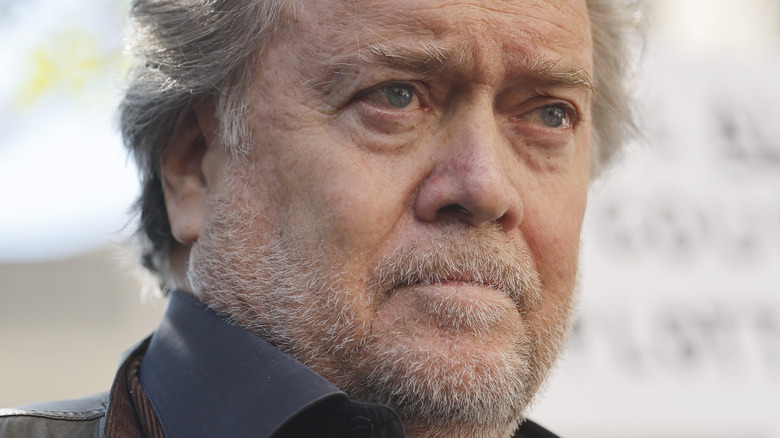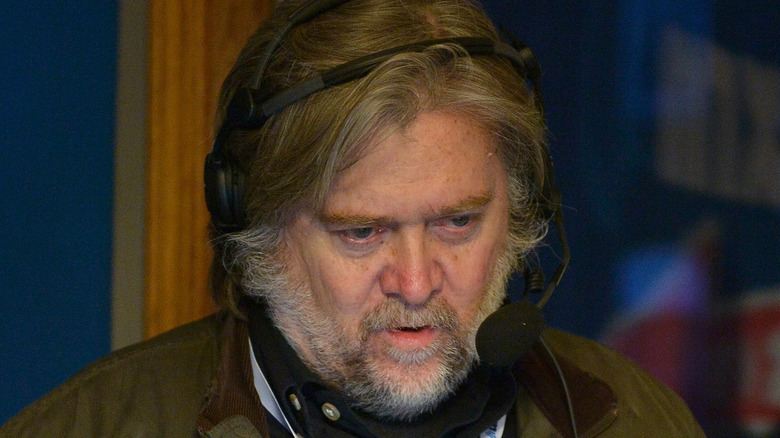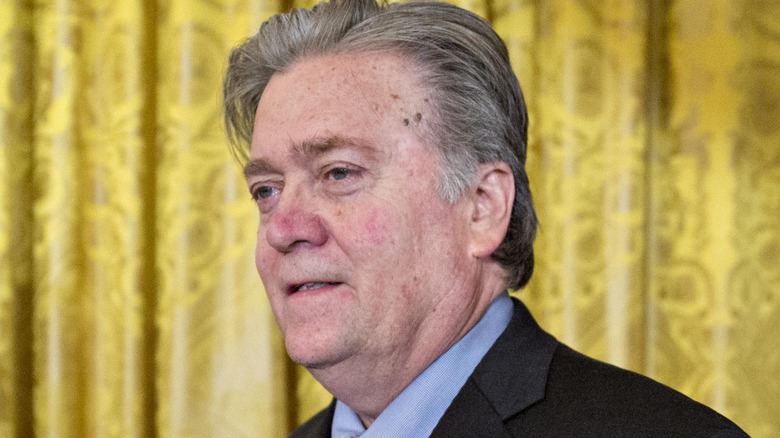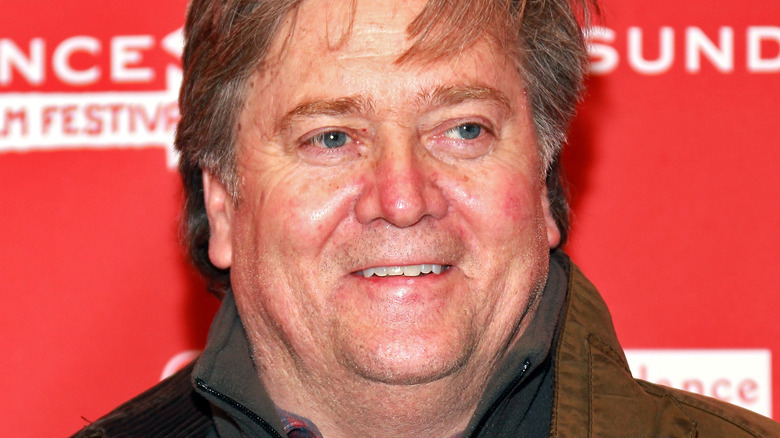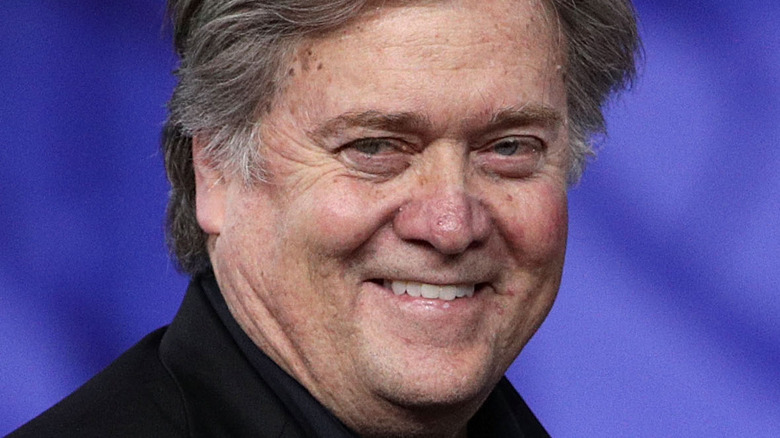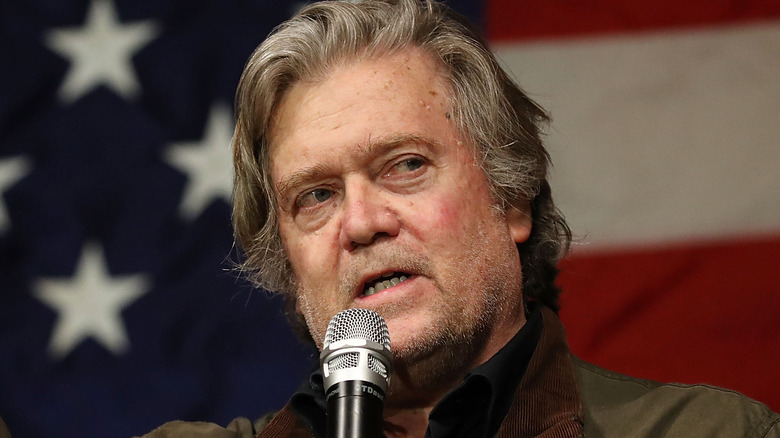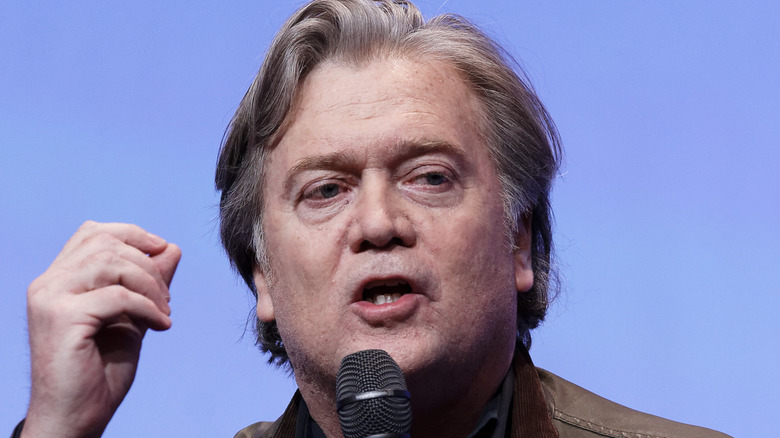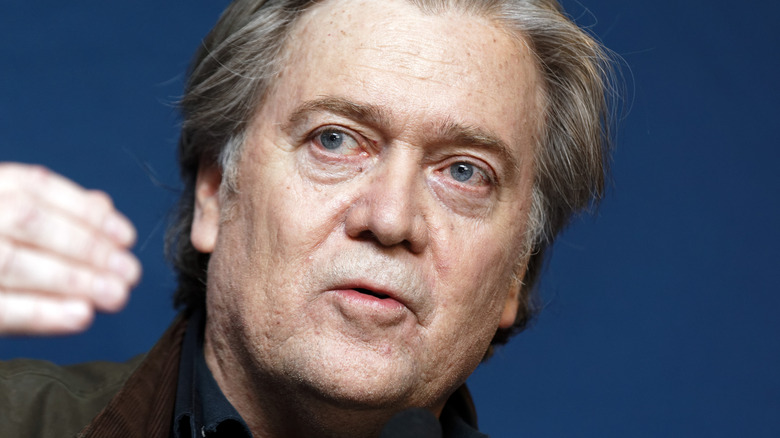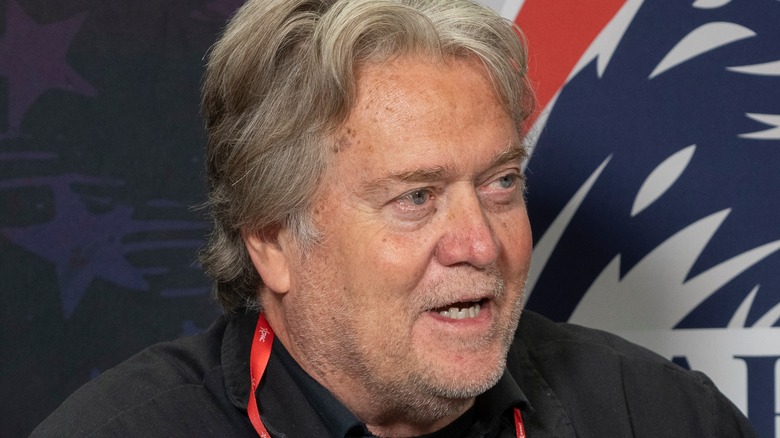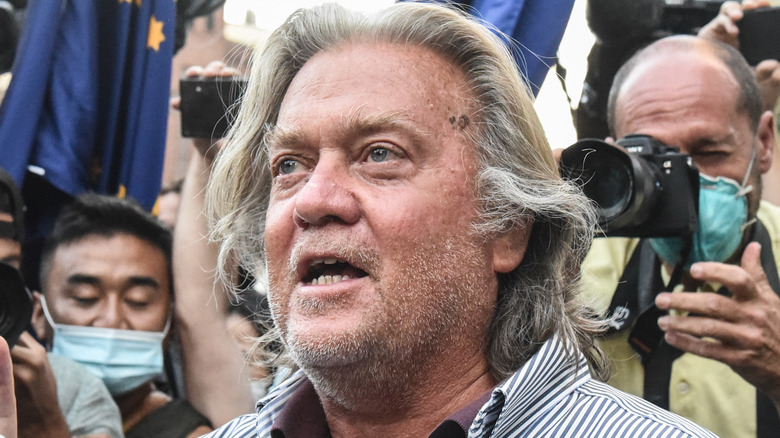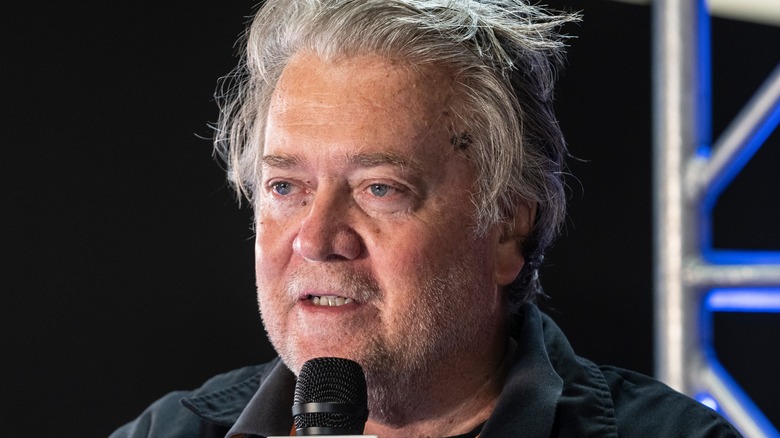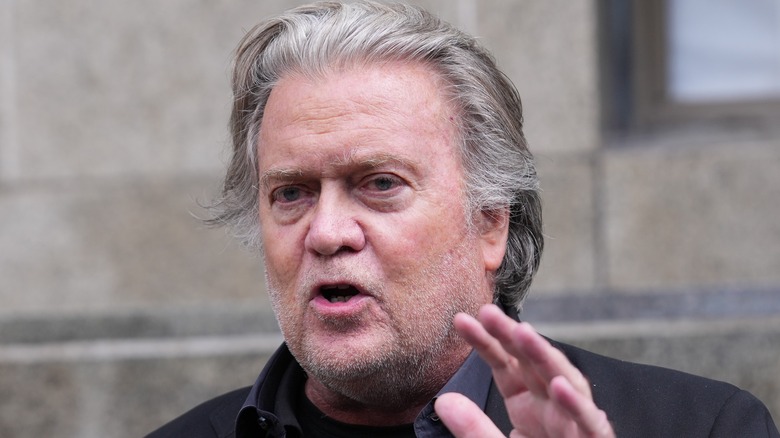The Rise And Fall Of Steve Bannon
The following article includes brief references to alleged sexual assault, racism, and sexism.
Steve Bannon has occupied several posts from a Naval officer and investment banker to a movie producer and media executive, but he's best remembered for his association with Donald Trump, taking the controversial real estate mogul from his posh New York digs to that cushy Oval Office in Washington, D.C. seemingly against all odds. In 2016, when legacy media like The Atlantic and The Washington Post buzzed about the likelihood that Hillary Clinton would be the first woman to shatter the Oval Office glass ceiling, Trump eviscerated those hopes into shards. Bannon commandeering a campaign that derailed an estrogen-fueled movement was one thing, but doing it by pinning hopes on a personality whom now-defunct Spy Magazine once dismissed as a "short-fingered vulgarian" (via ABC News) was another. For his part, Bannon appeared unfazed with Trump, deemed sexist, racist, and homophobic by his numerous detractors.
But his success as Trump's political strategist would be short-lived. Seven months after assuming an office at 1600 Pennsylvania Avenue, then-President Trump would fire Bannon, who would subsequently be dogged by scandals, including his alleged money laundering of a controversial border wall and connection to the Capitol building riot. Handed a four-month jail sentence after defying a Congressional subpoena, Bannon has appealed the decision amid scuttlebutt that the once-omnipotent power broker is down for the count, at the time of this writing. But the jury is still out on determining whether he's out of the game for good. This is the rise and fall of Steve Bannon.
Steve Bannon comes from a left-leaning family
Steve Bannon's status as a polarizing figure in the U.S. who galvanized an alt-right population base that helped carry Donald Trump to the White House in 2016 seems odd, considering his contentious legacy scrapes against the grain of his family upbringing. Born in 1953 in Norfolk, Virginia to Martin and Doris Bannon, he was raised in a decidedly left-leaning, working-class household.
"I come from a blue-collar, Irish Catholic, pro-Kennedy, pro-union family of Democrats," Steve later told Bloomberg. Growing up, he excelled as a student in high school, but even while attending Virginia Tech, he wasn't afraid to show off his blue-collar roots working in a junkyard when he wasn't studying. "He would come home looking like a coal miner," said his brother, Chris Bannon, to The Boston Globe. "Mom would make him strip down to his boxers and spray him off with a hose before he could come in."
During those post-secondary years, classmates interviewed by the Globe revealed that Steve Bannon never showed any racist or sexist inclinations that detractors in government and media circles would claim in later years. He also apparently never demonstrated a keen interest in politics, even while running for president of Virginia Tech's student government. Former schoolmate Susan G. Oliver thought it was notable that he asked her to join his ticket as vice president at the time. "That was a pretty impressive and courageous thing for him to do back then," she said to The Virginian-Pilot.
Life in the Navy makes Steve Bannon go political
After graduating from Virginia Tech with a bachelor's degree in urban planning in the late '70s, Steve Bannon was a Navy officer for seven years, occasionally stationed on the destroyer USS Paul F. Foster. Per the Military Times, the ship never saw any action during his tenure, although one tragedy forever triggered and shaped his politics. In 1980, the Foster was sailing in the Gulf of Oman with the aircraft carrier USS Nimitz, the launching point for a helicopter mission to rescue U.S. Embassy personnel held hostage in Tehran, Iran. Bannon later heard that the mission failed after two choppers crashed, killing eight soldiers.
According to The Washington Post, many personnel onboard the Foster blamed U.S. President Jimmy Carter for the mishap. One sailor recalled Banner being so angry with the Democrat commander-in-chief, he hoped Republican presidential contender Ronald Reagan would win the next election. "It shattered his confidence in President Carter," a rear admiral at the time, Edward "Sonny" Masso, explained. "It made him all the more in the tank for Reagan."
Motivated, Bannon was undoubtedly pleased when Reagan beat Carter for the keys to the Oval Office and thrilled when he himself landed a Pentagon job with the new administration, working as an assistant for the chief of naval operations. It enabled him to study national security at Georgetown University, where he graduated with a master's degree. Bannon left the Navy in 1983 to study business at Harvard.
Steve Bannon jumps from Wall Street to Hollywood
Upon graduation from Harvard in 1985, Steve Bannon got a job as an investment banker with Goldman Sachs, where he earned praise from colleagues like future short-lived Trump press secretary Anthony Scaramucci. "He's one of the smartest people I know," said Scaramucci to TheStreet. Two years later, Goldman Sachs sent Bannon to Los Angeles to increase its footprint in the entertainment industry; but lured by an environment that fostered his hero, Ronald Reagan, Bannon left the company in 1989 to start his own film investment company.
Bannon also became executive producer in other ventures, bankrolling flicks like Sean Penn's "The Indian Runner" in the early '90s. But Bannon really wanted to make political documentaries and dramas reflecting his right-wing sensibilities. By 2004, the first work to realize that aspiration surfaced with the dramatized biopic "In the Face of Evil: Reagan's War in Word and Deed." Bannon later told Bloomberg, "We screened the film at a festival in Beverly Hills, and out of the crowd comes this, like, bear who's squeezing me like my head's going to blow up and saying how we've gotta take back the culture."
Bannon would follow that up with outings featuring similar conservative and sensationalist themes, like "Sarah Palin: Undefeated," "Battle for America," and the doomsday-laced "Generation Zero." "Bring on the Apocalypse," said Ann Hornaday, The Washington Post's film critic, about "Generation Zero" to "Frontline." "There's an almost fetishist desire to see everything blow up."
He hooks up with Breitbart News
Not merely satisfied to entertain a small but growing audience of conservative malcontents with documentaries and dramas, Steve Bannon sought to extend his media reach in 2011 when he joined the Breitbart News board. The scrappy, right-leaning website was only four years old at the time, founded by media maverick Andrew Breitbart. Right from the start, the site redressed the apparent huffiness of the mainstream republican base, opting for a more in-your-face attack of the left, a perfect fit for Bannon. "We're the platform for the alt-right," Bannon would say to Mother Jones some years later. He also chastised conservatives whom he believed had gone soft, particularly on issues like immigration and what he called "crony capitalism," as the site became more visceral in its content, even dedicating a since-deleted section to "Black Crime," per Vox.
When Andrew Breitbart died in 2012, Bannon took over leadership of Breitbart's umbrella company and had a more hands-on approach to the news site's management. "Steve ran the site and controlled the content as a dictator, not only limiting the expression of his journalists but also purposefully changing the narrative to increase vitriol, playing to the fears of his readers," wrote former Breitbart rep Kurt Bardella in The Hill.
Bannon probably wouldn't have argued that point, as made vividly clear in 2012 in an email to conservative filmmaker Ben Howe. "This is about power, Ben, and who is going to exert it," he reportedly wrote (via BuzzFeed News).
Steve Bannon runs the Trump presidential campaign
Someone who shared Steve Bannon's power perspective was Donald Trump, who by the summer of 2016 had secured the Republican nomination and hired Bannon to helm a path to the presidency. By then, Bannon's tenure at Breitbart had earned him the title of what Bloomberg called "the most dangerous political operative in America," a notoriety Trump felt would be a huge asset. Bannon used his Breitbart experience to identify an angry demographic that railed against the entire political establishment that was much larger than previously perceived ꟷ matching the strategist's personal visions. "He's been the forerunner intellectually of this moment," pollster Patrick Caddell told The New York Times. "His ideology is that of the outsider and the insurgent."
At times, Trump's campaign was in jeopardy, such as when an "Access Hollywood" tape revealed a hot-mic'd Trump bragging about groping women just days before a second debate against opponent Hillary Clinton. Bannon then orchestrated a media conference with women accusing Hillary's husband, former President Bill Clinton, of sexual improprieties during his presidency. These women also attended the debate. "We're going to turn [Bill Clinton] into Bill Cosby," Bannon apparently said at the time (via People).
Just days before the election, the FBI started investigating Clinton's alleged mishandling of confidential emails dumped by WikiLeaks, an incident that arguably handed the election to Trump. Per Politico, when asked in front of Congress about the incident's effect on the election, Bannon said, "I'd view that as hurting Hillary Clinton and helping the Trump campaign."
If you or anyone you know has been a victim of sexual assault, help is available. Visit the Rape, Abuse & Incest National Network website or contact RAINN's National Helpline at 1-800-656-HOPE (4673).
He hits the White House as chief strategist
When Donald Trump won the 2016 presidential election, he appointed Steve Bannon to be the administration's chief strategist, a title hinting that the job would hardly be mundane. "He wants to be the intellectual, strategist bomb-thrower," said longtime Republican Rep. Newt Gingrich to PBS News Hour. "He does not want to be the guy who makes the trains run on time." Bannon wasted little time advising Trump, who nominated right-skewing judge Neil Gorsuch to the Supreme Court, and signed executive orders that halted refugee programs, while preventing the immigration of citizens from seven largely Muslim nations. Per CNN, Bannon was also orchestrating ways to combat what he thought were China's unfair trading practices with the U.S.
Bannon's tenure in the White House was short, however, as he reportedly started clashing with Jared Kushner, Trump's political adviser and son-in-law — a conflict that resulted in the strategist being removed from the National Security Council roughly two months after his appointment. By August 2017, Bannon was out of a job, creating speculation that the staff in-fighting may have resulted in his dismissal after just seven months. CNN hinted that pop culture's portrayal of Bannon as the puppet master in the White House, an allegation satirized frequently on "Saturday Night Live," might have made the arguably egocentric president angry.
Either way, Trump didn't mince words about axing his strategist. "When he was fired, he not only lost his job, he lost his mind," he later claimed (via The Guardian).
Steve Bannon sets his sights internationally
After getting dumped from the White House, Steve Bannon snared the head of the news division at Breitbart and immediately shot back at the administration that let him go. "The Trump presidency that we fought for, and won, is over," Bannon stated to The Weekly Standard (via GQ). "It'll be something else. And there'll be all kinds of fights, and there'll be good days and bad days, but that presidency is over." But his reunion with Breitbart was also over in a matter of months, when Bannon used the platform to take shots at White House adviser Jared Kushner. As previously mentioned, Trump — Kushner's father-in-law — then lashed out at Bannon, who had also declared the president's oldest son, Donald Trump Jr., to be "treasonous" and "unpatriotic," per Reuters.
Shortly after leaving Breitbart in 2018, Bannon decided to promote to the rest of the world the very brand of populism that elected Trump. He set up camp in Italy and travelled across Europe, holding discussions with the likes of Marine Le Pen, leader of France's ultra-right party National Front, and Hungary's autocratic Prime Minister Viktor Orbán. Bannon also mulled over starting web-based publications across the continent. "Whether I do it or a local entrepreneur does it, there are going to be these populist nationalist news sites that pop up in the next year online," he said to The New York Times. "That will only take these things to the next level."
But it wouldn't be long before Bannon's online experiences would land him in trouble.
He meets his match with social media
Steve Bannon had a pretty good ride in his drive to dominate the media with his populist views, although the films he made after leaving Goldman Sachs in Los Angeles were hardly box office sensations. He enjoyed success at Breitbart News, until he was forced to leave. And a show he had on SiriusXM also faced the axe after his departure from Breitbart. Then Bannon faced additional scrutiny in 2018 over news that Cambridge Analytica, a consulting firm Bannon helped form five years earlier, had purchased from Facebook about $1 million worth of data containing the personal information of some 50 million users to test voter-persuasion tactics, according to The Washington Post.
Bannon denied he had anything to do with the acquisition and use of the social media company's information, per ABC News, until a former Cambridge Analytica consultant challenged that claim on Twitter, even posting an internal memo as alleged evidence. In the end, Facebook made a public apology and suspended Cambridge Analytica from future such ventures, while Bannon suffered another blow to his credibility.
In 2020, he found social media wasn't warming up to his videos, especially one where he demanded the beheading of Chief Medical Advisor Dr. Anthony Fauci and FBI Director Christopher Wray. YouTube and Facebook removed the offending video, while Twitter added a more severe penalty of permanently suspending his account. "You either get with the program or you are gone," Bannon said on the video (via CNN). Social media did neither.
Trump asks Steve Bannon for help after losing an election
"Steve Bannon has nothing to do with me or my Presidency," said then-President Donald Trump in a prepared 2018 statement (via CNBC) about the chief strategist he dumped just seven months after taking the White House. Despite that denial, and after losing the 2020 election to President Joe Biden, Trump seemingly needed Bannon's expertise to reverse the results. According to passages in Bob Woodward and Robert Costa's book "Peril" (via CNN), Bannon's handiwork was allegedly all over the plot to orchestrate what is now called "The Big Lie."
One section claimed that Bannon told Trump to focus on January 6, 2021 in Congress, where then-Vice President Mike Pence was to ratify the 2020 election results. Optics had it that if Pence overturned the outcome, Trump would still be president, a claim not mentioned in the Constitution, per AP News. According to ABC News, Bannon also co-organized and promoted a live rally with the "March for Trump" collective of activists in Washington D.C., where Trump was reportedly meant to stir up further dissent. When word got out that Pence ratified the election results, Trump supporters violently stormed the Capitol building, injuring dozens of law enforcers and killing five people.
Perhaps just as telling was Bannon's prophecy the night before the riot on his "War Room" podcast (via The New Republic): "All hell will break loose tomorrow." As it turned out, Bannon was right. After the carnage, a bipartisan Congressional committee investigating the incident had a few questions for Bannon.
The former strategist gets into trouble building a wall
From the start, Steve Bannon bought into former President Donald Trump's grand scheme to build a giant wall on the U.S.-Mexican border to keep out so-called illegal immigrants. However, that same fabled wall couldn't block the consequences of Bannon's alleged shenanigans surrounding the project. Bannon chaired a GoFundMe initiative called We Build the Wall, which began in 2018 and had already accumulated $25 million with five miles of the structure built by 2020, per Reason. That same year, authorities in Connecticut arrested Bannon on a friend's luxury yacht; later, he was indicted with counts of conspiracy to commit wire fraud and money laundering involving $1 million.
"I'm not going to back down," Bannon, who was pardoned the following January by Trump, said on his "War Room" podcast (via CNN), claiming, "This is a political hit job." Hit job or otherwise, Bannon dodged a bullet, but he seemingly didn't count on a few stipulations that would later go against him. For openers, Trump's pardon applied only to federal offenses and, because the trial was still continuing at the time of the pardon, a lack of a conviction meant a double jeopardy loophole wouldn't help him, per PBS News Hour. That left the opportunity for the State of New York to go after Bannon, who was arrested in New York in September 2022 on the same charges.
He has since pleaded not guilty and is out on bail, at the time of this writing. However, Bannon potentially faces a maximum 15-year prison sentence, if convicted, according to Reuters.
Steve Bannon faces a four-month prison sentence
For all the hot water he's landed into during his tempestuous political career, Steve Bannon has had a remarkably clean record. That is, until the above-mentioned money laundering indictment he's trying to fight. But his legal troubles continued on October 21, 2022, when a federal judge issued Donald Trump's former political strategist a four-month prison sentence after a grand jury found him guilty of contempt of Congress. More specifically, Bannon refused to abide by a subpoena to appear before the House bipartisan committee investigating the Capitol riots on January 6, 2021. He was also levied a $6,500 fine, per The Guardian. Federal prosecutors had asked for a six-month sentence and a $200,000 fine, as reported by NPR.
Under federal law, Bannon would have 14 days to file an appeal and remains a free man, as of this writing, after U.S. District Judge Carl Nichols determined he posed no danger to the community and showed no signs of fleeing the country, according to CNN. Speaking at a hastily arranged media conference after the sentence, Bannon said (via BBC News), "Today was my judgement day," before declaring that a similar fate would hit Democrat Congressional candidates once the midterm elections conclude on November 8.
Speaking later that night on the Fox News program "Tucker Carlson Tonight," Bannon appeared calm while alleging that the legal sentence was politically motivated. Still, he was totally prepared to fight the results. "I've got a great legal team," he said. "My legal team's working on the appeals right now."

